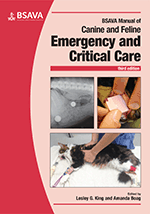
Full text loading...

The placement and maintenance of intravascular access is one of the most important skills for any veterinary surgeon (veterinarian) and veterinary nurse working in emergency and critical care medicine. This chapter addresses the different types of vascular access (catheter placement and maintenance) and summarizes complications that may occur.
Vascular access, Page 1 of 1
< Previous page | Next page > /docserver/preview/fulltext/10.22233/9781910443262/9781910443262.2-1.gif

Full text loading...











